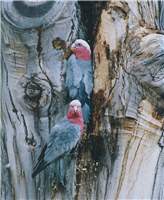Family
Cacatuidae
Genus
Cacatua
Species
roseicapilla
Threats/Control Methods - Regional
The removal of mature eucalypt trees for urban development and agriculture limits the Galah's ability to breed successfully, as they depend on the same tree to be available year after year. Galah's can cause a threat to local woodlands by spreading the seeds of weed species.
Threats/Control Methods - Local
Free roaming domestic pets will attack young birds in their first few months of life.
Local/Urban Actions
Seed bearing weed species should be removed from the garden to limit their distribution into the surrounding native woodland.
Common Names
Galah, Goulie, Roseate Cockatoo, Rose-breasted Cockatoo, Willie-Willock
Distinguishing Features
The Galah is easily identified and is one of Canberra's most familiar birds. It has a rose-pink head and underbelly, with a paler pink crown and grey wings, back and tail. The male and the female have similar colouring.
Survey Techniques
Call and visual identification.
Species Call
A distinctive high-pitched metallic screech, 'chirrink-chirrink'.
Similar Species
While very distinct, the Galah has a similar shape to the Gang-Gang Cockatoo (Callocephalon fimbriatum ). The Gang-Gang Cockatoo has darker grey plumage fringed with white. The female is entirely grey with the male having deep pink to red plumage on the head.
Distribution
The Galah is common over most of Australia.
Country of Origin
Australia.
Conservation (Pet/Pest) Status - Regional
They are common around Canberra all year round, peaking slightly in winter (COG).
Conservation (Pet/Pest) Status - National
Secure, not listed under the EPBC Act 1999. They are listed as an official Native Household Pet Animal. Galahs eat the seeds of cultivated crops, making them a pest in some agricultural regions. Their population numbers are now growing in coastal areas where land is opened up by clearing.
LSCCES Population
The species was recorded across the whole survey area, with highest numbers in Turner.
Associated vegetation community
Any fairly open timbered region with access to a reliable water source is suitable for the species, including suburban areas with parklands.
Limiting Resources
Galahs require nest hollows in mature eucalypt trees, returning to the same tree year after year.
Breeding
Galahs form permanent bonds and both sexes incubate the eggs and care for the young. They choose a tree hollow between 2-20m from the ground and line it with leaves and small twigs. Clutch size is about 3-6 and requires about 30 days of incubation. The young are dependant for their first three months and can be seen in Canberra from mid-October through the summer months. About half the young birds die in the summer while they are learning to survive on their own.
Behaviour
The Galah is noisy and conspicuous, often seen hanging from telegraph wires or feeding on the ground. They are social birds and move around and feed in large groups of around 30 birds and up to 1000 birds in open bushland. They are strong flyers, and have been timed at over 50km/hr.
Functional Group
Food Species
Galahs are often seen on the ground, feeding on whatever seeds they can find.
Predators
Both feral and domestic Cats (Felis catus) and Dogs (Canis familiaris) will attack young birds.
Interesting Fact
Galahs can breed with other members of the cockatoo family, including the Sulphur-crested Cockatoo (Cacatua galerita ).
References - (reader suitability of references, P=Primary teachers, S=Secondary students, T=Tertiary students and researchers)
Books:Morcomber, M. 2000. Field guide to Australian Birds. Steve Parish Publishing, Archerfield. P, S, T
Schodde, R. and Tideman, S. (eds) 1990. Reader's Digest Complete Book of Australian Birds (2nd Edition). Reader's Digest Services Pty Ltd. Sydney. P, S, T
Veerman, P. 2003. Canberra Birds: A report on the first 21 years of the garden bird survey. Philip Veerman and Canberra Ornithologists Group. Canberra. S, T
Internet: Birds in Backyards 2006. [online]. Available at:http://www.birdsinbackyards.net P, S, T
Canberra Ornithological Group (COG). 2004. Birds of Canberra Gardens. COG and the ACT Department of Urban Services. [online]. Available at:http://garden.canberrabirds.org.au/ P, S, T
Online Publications:Department of the Environment and Heritage. 2002. List of native household pet animals. Australian Government. [online]. Available at: http://www.environment.gov.au/biodiversity/trade-use/lists/pets/index.html`Nix, H. and Cunningham, R. 2006. Birds of the Lower Sullivans Creek Catchment, Canberra ACT. Prepared for the Life in the Suburbs project using data from the Lower Sullivans Creek Catchment Ecological Survey (LSCCES). Australian National University. Canberra. [online]. Available at: http://www.lifeinthesuburbs.com.au/category.php?id=65

 Top
Top Top
Top